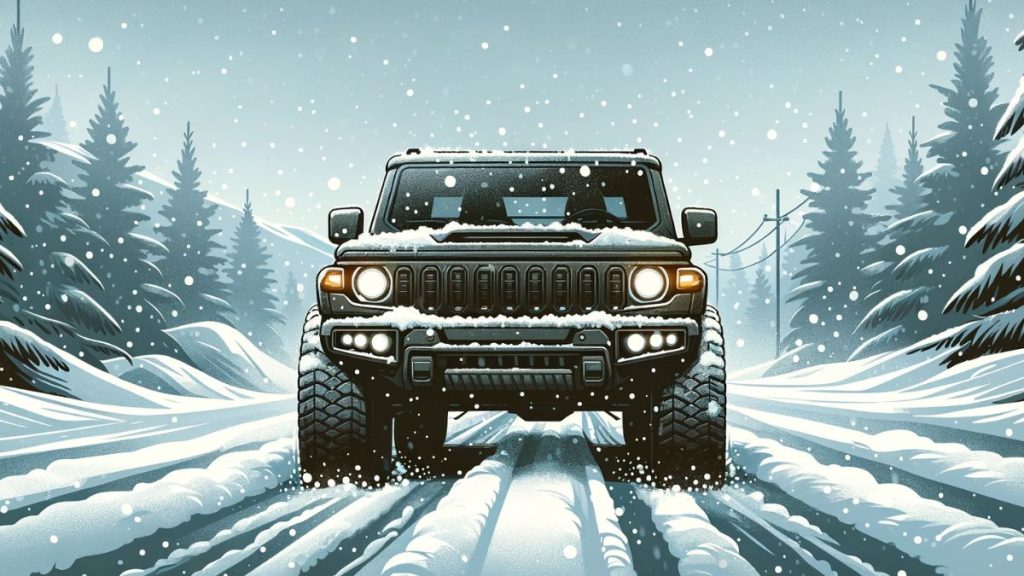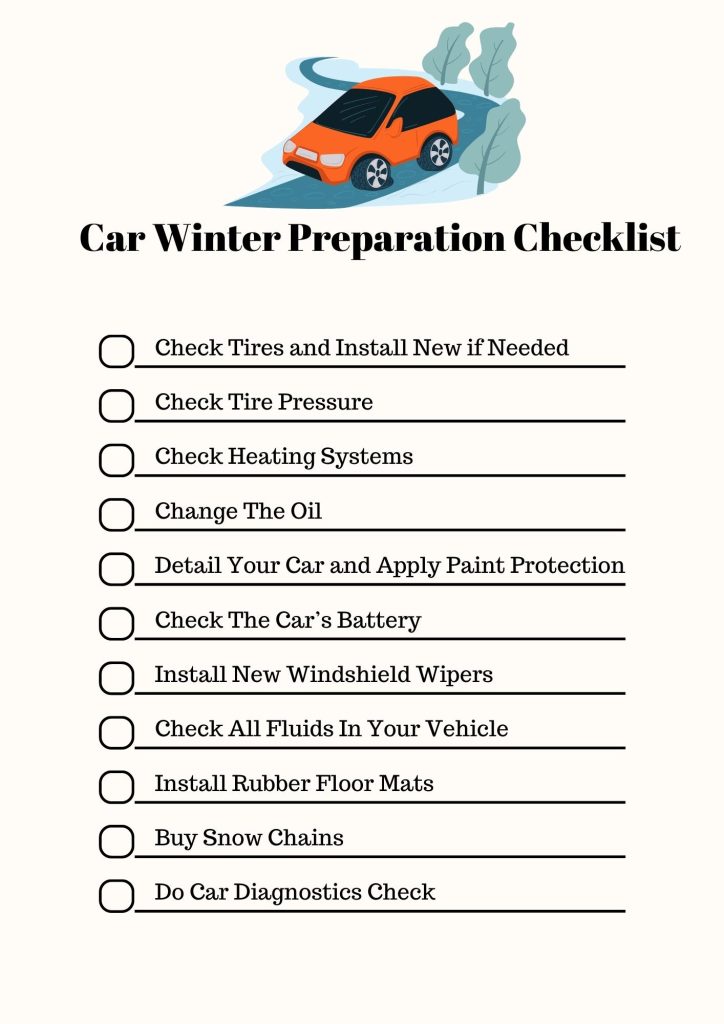How To Prepare Your Car For Winter? 11 Tips To Follow
Car Detailing Planet is a part of Amazon Associates. As an Amazon Associate, we earn from qualifying purchases. Read our Affiliate Disclosure to learn more.

Winter can be rough on your car, so it must be 100% ready for the cold months ahead. In this quick guide, I’ll show you how to prepare your car for winter from top to bottom.
Stick around till the end, as I’ve also included a simple checklist to ensure you don’t miss a thing!
1. Check Car Tires and Install New if Needed
Tires are one of the most important things you must check to get your car winter-ready. First off, let’s talk about the type of tires. I recommend going for winter tires, although all-season tires can work too.
Next, check the wear and tear on your tires. Follow local laws and look at the tread depth. If they’re too worn out, it’s time to invest in new or gently used ones.
Don’t forget to check the age of your tires as well. Over time, rubber hardens and loses its traction properties, which is crucial during winter. Remember, your tires connect you to the road, so don’t skimp on them. Quality tires can be a lifesaver!
2. Check Tire Pressure
Next up is tire pressure, which I’ve separated from the previous section because it’s something you should monitor all winter long. Keeping the proper pressure ensures optimal road grip in all weather conditions. Always follow the manufacturer’s recommendations for tire pressure levels.
Both too-low and too-high tire pressure are bad news. They lead to uneven tire wear and compromise your car’s handling abilities. So, make it a habit to check your tire pressure regularly throughout the winter.
3. Heating Systems
Don’t overlook your car’s heating systems; they must all be in top shape for winter. This includes air conditioning, mirror heaters, windshield heaters (both front and rear if you have them), seat heaters, and windshield washer fluid heaters if your car has them.
A properly functioning air conditioner helps reduce window fogging while working windshield and mirror heaters are crucial for maintaining good visibility. Seat heaters might not sound like a big deal, but trust me, they make a difference in comfort. They heat up quickly, making getting into a cold car much more pleasant.
I’ve often driven all day with just the seat heaters on, avoiding the need to crank up the car’s central heating system. This way, I stay alert even on long drives. So, make sure to check all these systems before winter hits.
4. Change The Oil
Changing your oil before winter is something I always recommend. While oil quality and viscosity are important year-round, a fresh oil change before winter makes it easier for your car to warm up and run more smoothly due to better oil viscosity.
This is especially crucial for those driving short distances within the city. In such cases, the engine rarely gets a chance to fully warm up before you reach your destination and turn off the car. So, do your vehicle a favor and get that oil changed before the cold sets in.
5. Detail Your Car and Apply Paint Protection
Before winter hits, it’s crucial to detail your car and thoroughly clean it of all dirt and grime. After that, apply some paint protection. I recommend using sealants or applying ceramic coatings that will last longer throughout the winter.
Doing this will protect your car from road salt, which can cause rust and damage the bodywork. There are also many other benefits to applying paint protection to your vehicle. Trust me, it’s a step you don’t want to skip.
6. Check The Car’s Battery
Cold winter temperatures mean your starters and heaters, especially diesel cars, need more juice to function correctly. That’s why a strong and healthy battery is essential. Many shops have devices to measure your battery’s strength, so check it out.
If the results are poor, replace the battery with a new, reliable one with enough power to start your engine quickly. A weak battery is the last thing you want to deal with in the middle of winter.
7. Install New Windshield Wipers
Summer heat tends to wear out windshield wipers, so I like to replace them before every winter, and I suggest you do the same. The wiper’s rubber must be soft to clear your windshield effectively. If they’re old, the rubber will be hard, leading to poor visibility and even potential scratches on the glass.
Specific winter wipers are also available, which I highly recommend if you want the best windshield-clearing results. Trust me; new wipers make a noticeable difference.
8. Check All Fluids In Your Vehicle
In addition to oil, don’t forget about other essential fluids like windshield washer fluid—opt for a winter formula to avoid freezing—brake fluid, antifreeze (coolant), and Ad Blue if your car needs it.
The coolant is essential because it prevents your engine from freezing in cold temperatures and overheating in warmer conditions. A proper antifreeze mixture is crucial for engine longevity.
Brake fluid is another critical fluid; it transfers the force you apply on the brake pedal to the brake pads. In winter, moisture can contaminate the brake fluid, reducing its effectiveness and compromising safety.
So, make sure all these fluids are at the proper levels. It’s a simple yet vital step for a smooth-running and safe vehicle.
9. Install Rubber Floor Mats
It’s time to swap out your fabric floor mats for rubber ones. Why? Because winter brings a lot of precipitation and moisture, rubber mats will contain it instead of letting it soak into the carpet. Plus, rubber mats are much easier to clean than fabric ones and are more durable, standing up to all kinds of weather.
They might not look as nice, but they’re far more practical. If you often carry items in the trunk, I recommend getting a rubber liner for that space. Trust me, you’ll appreciate the convenience.
10. Consider Buying Snow Chains
If you live in a hilly area, a region with extremely low temperatures, or a place that gets a lot of snow, I strongly recommend buying snow chains and keeping them in your trunk, especially when going on trips. This is even mandatory equipment in some states, so you risk a fine if you don’t have them.
Snow chains can help you escape deep snow and ice, mainly if your car is rear-wheel drive. It’s a small investment that can make a big difference in your winter driving experience.
11. Do Car Diagnostics Check
A car diagnostics check using an OBD2 port is the last but certainly not least step on this list. When you connect your vehicle to the diagnostics system, the computer will flag any issues your car may have. Pay special attention to the ABS and traction control systems, which are crucial for winter driving.
You can even buy your own diagnostics tool for under $100, which I highly recommend. It’s a cost-effective way to keep tabs on your car’s health for winter and year-round. For instance, The Foxwell (check above) is a fantastic car diagnostics tool, and it costs less than $100.
Winter Car Preparation Checklist
Here’s a simple winter preparation checklist for cars that you can download to avoid missing anything.


